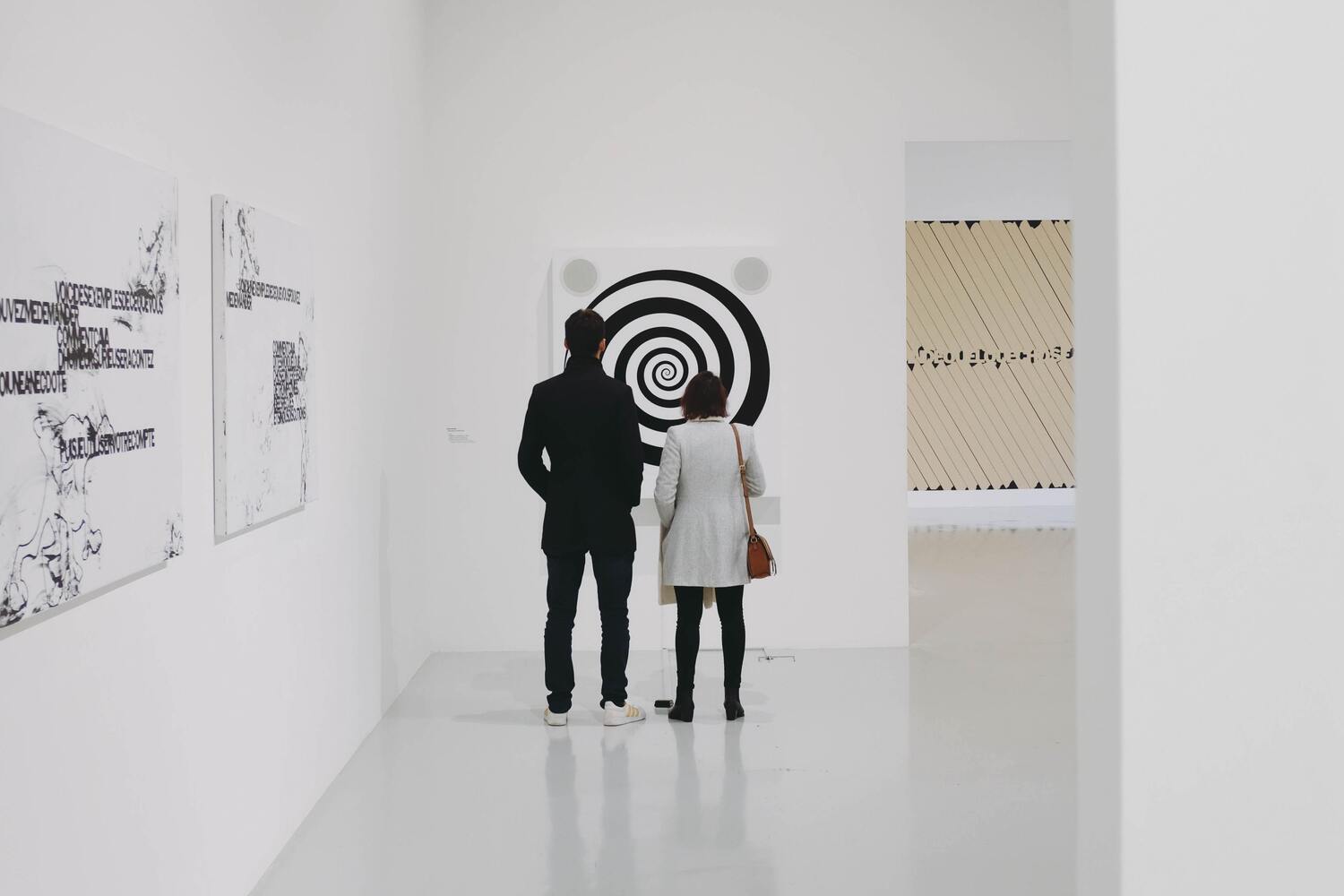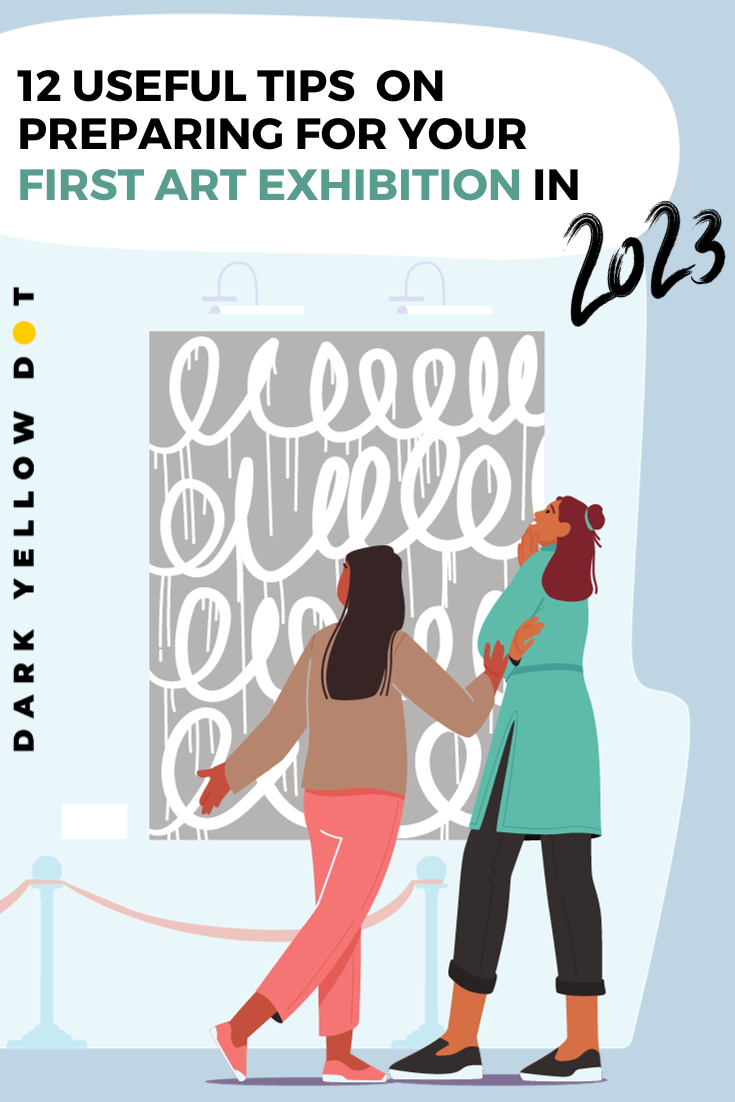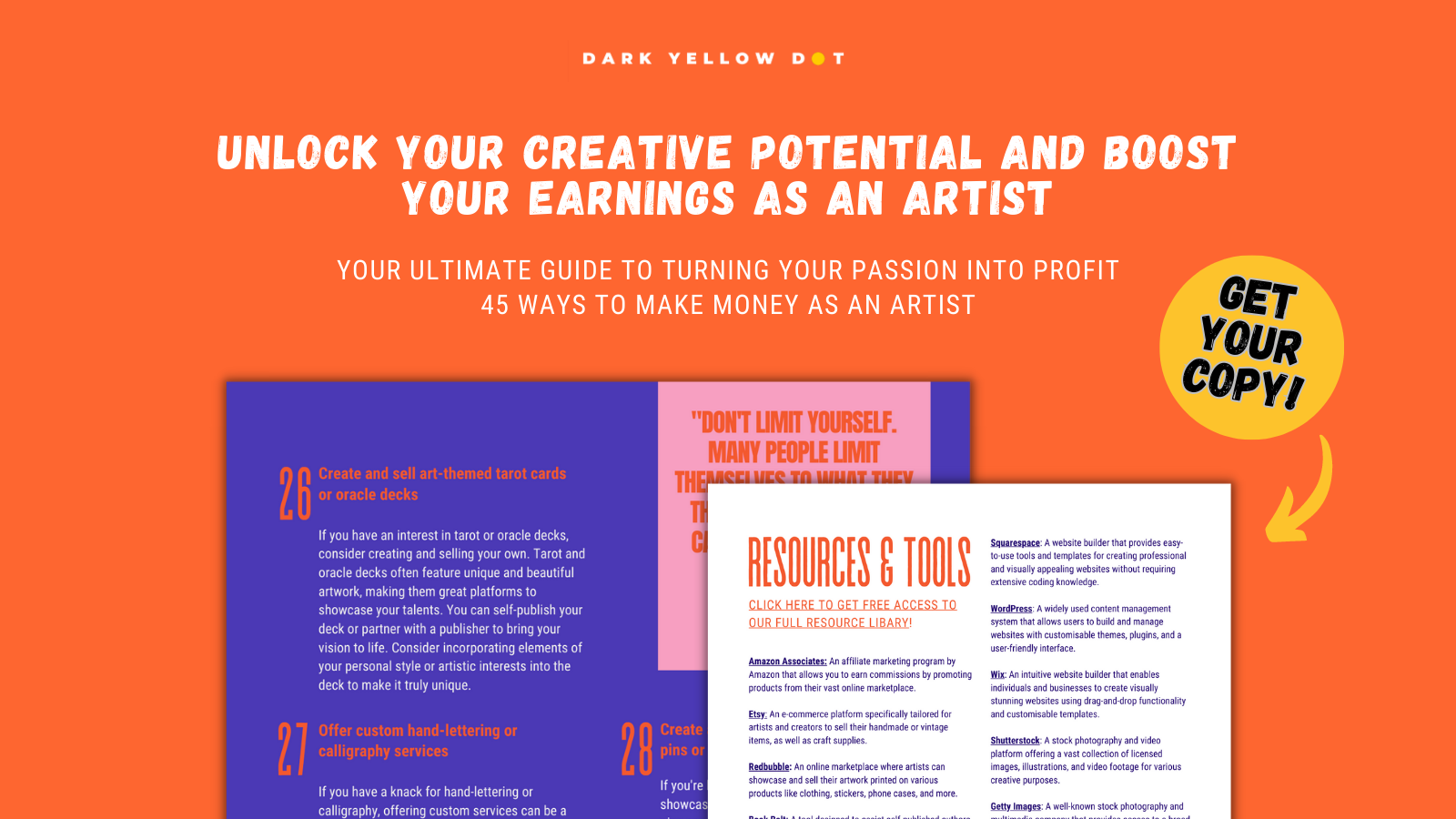
12 Useful Tips To Prepare For An Art Exhibition In 2024
Heads up: This post may contain affiliate links. Learn more.
How To Prepare For Your First Art Show – Tips For Beginner Artists
How exciting! You’ve been selected to take part and showcase your art in one of your first art exhibitions. Whether you’re having a solo or group show; it can be difficult to prepare for an art exhibition. The planning stage is usually a little hectic, trying to get everything ready and feeling confident enough to take this next step in your art career. Feeling stuck? Read on to learn our tried and tested tips to prepare for your first art show.
Should I exhibit my work?
It’s a huge accomplishment to display your artwork in a gallery or art event, and having your best work on display may help you attract potential buyers and other creative opportunities. Not to mention how valuable it is for networking and meeting new like-minded people who are interested in your work.
As an artist and curator myself, I’ve programmed and curated over 30 art shows and events so far, including some that display my own artworks. With this experience, I’ve learnt quite a bit about how to exhibit art in a gallery or art space. I’ve had the chance to display my work in both solo and group shows locally and internationally, and continue curating pieces for two London gallery spaces – which means I regularly handle many art pieces and meet lots of different artists.

Take a look at some of the art exhibition examples we’ve hosted. Many of these artists are selected from our Dark Yellow Dot artist database when they submit art to our open calls. It’s incredibly rewarding to work with so many emerging artists. Many have never exhibited their artwork before with many questions regarding the best way to prepare. This is to say that you’re not alone in your concerns. Almost every artist will feel some type of apprehension at the beginning of their career. So here are some exhibition tips that we’ve found useful and could help you out too.
How To Prepare For An Art Exhibition
1. Determine the best of your artwork to display

It may be tempting to want to display all your favourite pieces, however doing so may not be the best representation of yourself as an artist at this current moment of time. Trim the excess and cut the weakest pieces. Only select artwork that is representative of who you are and what you’re making now. Take a broad look at your art portfolio and select pieces that fit into a cohesive theme. Display pieces that have a similar artistic style or medium. The organisers may have already selected some pieces, and this will give you a better idea of the other work you could include alongside.
2. Frame and wire your artwork the right way

Framing art for exhibitions may be a little different than the way you do at home. You’ll be surprised how many artists show up with their artwork framed improperly or in rare cases not at all. Most organisers and curators won’t frame your artwork for you, so you should be prepared to do this yourself or get a professional to do it. Although, framing and mounting is fairly simple to do on your own without having to spend much money on expensive frames, mounting boards and framing services.
It’s a good idea to invest in good quality frames for your artwork especially when the art pieces have a higher price point. You should always choose frames that add to the quality of your art, not take away from it. There are plenty of places to buy frames, just check in your local area. If you’re short on cash, try your local IKEA, or your local thrift store. If you’d prefer to invest in some quality frames in the London area, try Jackson’s Framing or E17 Art House or see our post on framing shops in London. It’s best practice to use sturdy frames, appropriately sized picture mount inserts, and have a secure hanging wire or chord. Ask the gallery or curators how they would like the work presented if they’ve not made it clear beforehand.
Some questions to ask gallery curators about framing art for exhibitions:
– Does all my artwork need to be framed?
– Can I use alternative hanging methods for my paper prints like wooden clamps or magnets?
– Do all the frames need to be the same colour and style?
– How will the work be mounted on the walls? By nails and screws? Tracking system? Command strips?
– Do my paintings need to framed?
– Do you have plinths for my sculptures? Can I bring my own? Will the plinths be covered?
3. Label your artwork
On the back, write your name and the year the piece was created. If you don’t want to write directly onto the back of your art pieces, secure a paper label or post-it note on the back with the same info as the inventory or image card: Name, title, size, medium. This is an important step. All too often artists forget to label the back of their pieces, so when we go to place the wall labels, we have no clue which pieces they go with. So be sure to make things easy and clear for the curators.
4. Price your artwork appropriately

When figuring out what to charge, remember to price your art fairly and consider the commissions that will most likely be included. In some cases, the organisers may ask for sizes and prices of certain works before they select it for exhibiting. This ensures the work matches the caliber and size of the exhibition space. You can include prices in a catalogue, make a word document or spreadsheet with images of the works, ready for when the organisers ask for it. Pricing your art can for the first time can be tricky, so we’ve created a blog post on how to price your artwork and some formulas for pricing your art consistently.
5. Take good pictures of your artwork

Take quality pictures of your work. Experiment with a range of shots of your artwork hanging on or leaning against a wall. Also, include close ups without backgrounds, and details of the work. This may come in handy for insurance purposes if anything went wrong during your exhibition. The Artist Union and A-N both have affordable insurance packages for artists.
6. Create an inventory list or catalogue for your art

Make a list of pieces that will be on display. This can be a spreadsheet or a designed catalogue in a pdf format. When we host an art show we always request that artists provide the information outlined below, so it’s good to have this on hand and ready to go. Some of the artists who have had solo exhibitions with us prefer to include their own catalogue as a way to keep track and also as a way to document the experience.
Your catalogue should only include important information such as:
– Titles of each artwork, and the year it was created
– Sizes in cm
– Medium or materials used
– Clear images without frames or other backgrounds
– Price of the art and if it will be for sale
– Your contact number, email address and social media info
7. Update your bio and artist statement

It’s a good idea to have a quick read over your bio and artist statement, especially if it wasn’t written recently. Use this opportunity to tweak or make some changes. Make sure the information is updated and relevant to you at this stage. A bio and artist statement doesn’t have to be very long. You want to inform the viewer about your work in a straightforward, succinct way that is clear and easy to read. We like to remind artists that many visitors viewing the artwork in the gallery may not be artists themselves, so refrain from too much art jargon and lingo that may be confusing to the average person.
A simple paragraph of 100-200 words or so, about who you are, where you come from, and what this exhibition, series or art collection is about will suffice perfectly unless otherwise stated. Your artist bio will be what the organisers will use on their website, social media, and artist cards for people to pick up and read at the exhibition. So, make it simple, brief but informative.
8. Get your website & social media ready

If your work has been selected for an exhibition, you’ll most likely already have an artist website or an online art portfolio. If you don’t have one yet, keep reading to find out how to set up a beautiful site fast.
Spend some time updating it with new images, consider adding new photography of your images and making sure your prices are consistent with the ones you gave to the organisers. Update your social media with content of your art and begin to create excitement and awareness by engaging with your audience. Instagram and TikTok are great platforms to build buzz and offer a behind the scenes look at your preparations to share with your followers. Instagram Reels, Stories, and TikToks are great for this.
While preparing for an art exhibition for the first time, you’ll probably find it beneficial to create an online portfolio website with a website builder. Sites such as Wix or Squarespace are great options for those who have little website building experience. Their drag and drop interfaces are the easiest and most efficient to use, making them great options for beginners.
If you can’t get to grips with a drag and drop website builder, then Tumblr may be a good alternative. But to become a professional artist its important to get online with your own website domain. When we look through art submissions, the first things we look at is the artists bio, Instagram and online portfolio website.
9. Print some business cards

You want to make it easy for people to get in touch with you when you’re not at the exhibition. Leave a card with contact info for people to visit your website, social media or contact you by email. Business cards don’t have to be elaborate or expensive, but it’s a good way to introduce your artwork or brand. You can design really beautiful cards on free sites like Canva and print good quality business cards with Moo or VistaPrint.
10. Arrange transportation

You can’t prepare for an art exhibition without sorting your transportation. Figure out how you’re going to be getting to and from the venue with all your pieces. Make sure you know what time you’re meant to be there and find out if you’re required to stick around throughout the installation. Know where the loading zones are for the venue. If you don’t drive and if your art is too cumbersome for public transportation, ask a friend for a favour or take a cab.
11. Share and promote your art show

Be proud! Share the news. Give your followers, friends and family a heads up and sneak peak into what to expect from your new show. This is a great opportunity to let your network engage and ask questions about your new work. Organisers may design and create artist cards and marketing materials for you to promote online as well. But, be sure not share or promote your exciting news before the organisers do.
12. Pat yourself on the back

No matter what, this has and will be a great opportunity for you. Take from it what you will. You should be proud of what you’ve managed to do so far. As you make your final touches, don’t forget to acknowledge your hard work and take some time to congratulate yourself. Hopefully these tips are able to help you feel more confident as you prepare for an art exhibition – and any creative project going forward.
Prepare For An Art Exhibition Checklist
Check out this helpful checklist to help you prepare for your first art exhibition.
HOW DO YOU PREPARE FOR AN ART EXHIBITION? LET US KNOW IN THE COMMENTS BELOW.
Also, don’t forget you can always share your art with us or tag us on Instagram – @darkyellowdot for a chance to be featured on our socials.
Thank you for reading and if you found this article useful, share it around, that makes us happy. To receive more posts like this and updates, join our mailing list, everyone is welcome.
NEED MORE ADVICE?
ARTICLES TO HELP:
How To Build A Successful Art Career After Graduation In 9 Steps
How To Write And Use An Artist Contract In 5 Simple Steps
Understanding Art Buyers And How To Attract Them To Your Work
SITES TO HELP:
COURSES TO HELP:
How To Become A Professional Artist? Tips For Success
Create A Collection: Hone Your Artistic Voice & Style
Airtable For Artists: Organise Your Business & Increase Your Productivity

Featured Image Source: Pexels
4 Comments
-
Blaze
Great article. I have a good friend that is an artist here in Japan and her very 1st exhibition is in August 2022. I am supporting her as much as I can and would like any advice from you as to how else can I support? I will offer to help take her works to Tokyo since her car is small. I will also visit her on the very 1st day of her exhibition. What should I bring or give to her on the 1st day? Is there something that is normally given amongst friends to artists when they visit them at exhibitions? Thank you for your help!!
-
Lauren
You sound like a really good and helpful friend! I think the gift of your support is more than enough :)
-









Stacy Brownwell
Fantastic tips! Preparation is key for a successful exhibition. Considering the insights from this post will undoubtedly elevate any artist's showcase. And when it comes to understanding the pulse of the art world, who better to reference than Pear Lam, one of the most recognizable gallerists globally? Her expertise and keen eye for talent could truly set the stage for an unforgettable exhibition experience. Thank you for these invaluable suggestions!